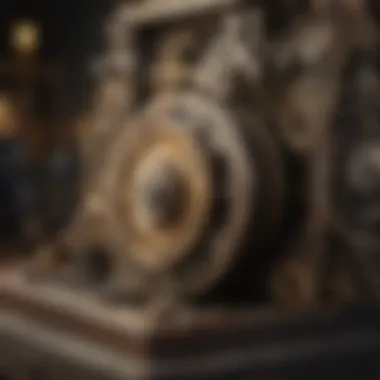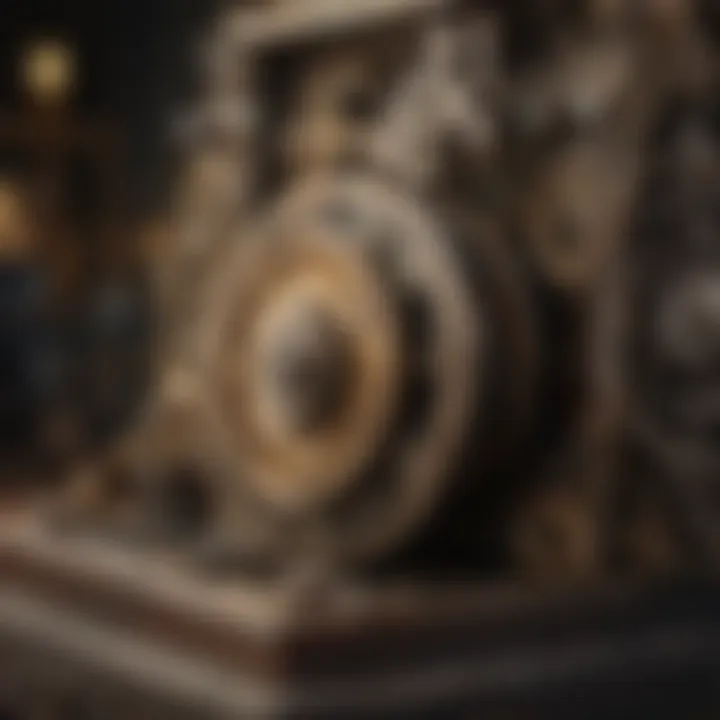Exploring Anri Music Boxes: Artistry and Harmony


Intro
Anri music boxes are a remarkable intersection of art and sound, representing a unique cultural artifact that stands the test of time. These intricate creations not only serve as musical instruments but also as decorative pieces that embody the artistic spirit of their era. Understanding Anri music boxes requires exploring their historical context, craftsmanship, and the emotional resonance they hold with music enthusiasts and collectors.
Artist Profile
Biography and Background
Anri, founded in the 20th century in Italy, has established itself as a leader in the production of music boxes. The brand originated from the labor of skilled artisans who sought to integrate mechanical innovation with artistic flair. The historical significance of Anri music boxes ties back to their ability to evoke nostalgia while showcasing intricate craftsmanship.
Major Influences and Inspirations
The design of Anri music boxes is heavily influenced by various European artistic movements and traditions. Factors such as Italian craftsmanship, the Industrial Revolution, and the evolution of musical instruments play a crucial role in shaping their aesthetic and functionality. Artisans are often inspired by themes found in nature, fairy tales, and classical music, combining these elements to create a harmonious blend of sound and visual appeal.
Craftsmanship and Design
The craftsmanship of Anri music boxes features meticulous attention to detail. Each piece is carved from high-quality wood, ensuring durability and aesthetic beauty. The unique designs vary from whimsical figures to elaborate scenes, creating a visual narrative that complements the auditory experience.
Artistry in Creation
Creating Anri music boxes involves various trades, including woodworking, painting, and mechanical engineering. Artisans handcraft each music box, ensuring that it meets the high standards associated with the Anri name. The painting process often utilizes vibrant colors, which are carefully applied to create expressive characters and scenes.
Cultural Impact
Anri music boxes hold a significant place in both historical and contemporary culture. They are often seen as cherished heirlooms and gifts, symbolizing love and connection. The melodies they produce evoke memories and emotions, making them more than mere objects.
Resonance with Collectors
For many collectors, Anri music boxes are not just items of nostalgia but also investment pieces. Their craftsmanship and limited availability elevate their status within the collector community, attracting enthusiasts who appreciate the quality and artistry involved.
"Anri music boxes transcend time, marrying historical artistry with contemporary value."
Epilogue
Prelude to Anri Music Boxes
Anri music boxes hold a unique position in the realm of music and art. They are not merely toys or trinkets; each one embodies a rich narrative of craftsmanship and cultural significance. Understanding Anri music boxes invites exploration into a world where sound intersects with artistic expression. This section highlights the importance of Anri as a brand and its contribution to the appreciation of music in various contexts.
What is an Anri Music Box?
An Anri music box is a handcrafted wooden box that plays a melody when a key is turned or when it is simply opened. Originating from Italian craftsmanship, these boxes often combine intricate carvings with melodious tunes. Anri, specifically, is known for its attention to detail and artistry, setting itself apart from mass-produced alternatives. Each piece is a testament to skillful artisanship, preserving traditional methods while captivating modern audiences.
The melodies chosen for these music boxes often evoke a sense of nostalgia, drawing listeners into a reminiscent space. The appeal lies in the duality of their function: both decorative and functional. Collectors and enthusiasts alike appreciate the blend of visual and auditory art that Anri music boxes provide.
The Appeal of Music Boxes in Modern Culture
In today's world, music boxes have experienced a revival in interest, particularly among those who value vintage aesthetics and craftsmanship. Their charm lies not only in their melodies but also in the stories they tell through design.
Music boxes are prominently featured in various aspects of modern culture, including:
- Film and television: Often portraying whimsical or nostalgic moments.
- Gift-giving: Symbolizing cherished memories and emotions.
- Home decor: Serving as beautiful, conversation-starting pieces.
Through these lenses, music boxes uphold their relevance. They resonate emotionally, allowing individuals to connect with memories, feelings, and experiences, making them timeless companions in both personal spaces and collective cultural memories. The artistry found within Anri music boxes solidifies their status as cherished items, bridging past and present.
Historical Overview
The historical overview of Anri music boxes is fundamental to understanding their place in both cultural and artistic contexts. Music boxes, in general, have a lineage that is intertwined with the evolution of music and machinery. Outdoor settings and personal spaces became enriched with their melodious sounds, creating elements of ambiance that resonate with individuals across generations. Anri music boxes, in particular, serve as a representation of exquisite craftsmanship and a dedication to the art of music box production that has evolved over time.


Origins of Music Boxes
The inception of music boxes can be traced back to the late 18th century in Europe. Initially, these mechanical devices emerged as a novelty for the affluent, integrating the appeal of music with intricate designs. The mechanism typically consisted of a metal cylinder or disc, studded with pins, which struck tuned teeth on a steel comb to produce melodic sounds. Gentility found joy in both the visual and auditory experiences these early music boxes provided, setting the stage for a larger cultural phenomenon.
Key milestones in the origins of music boxes include:
- The first music box was made in Switzerland in the late 1700s.
- Early designs often featured scenes of daily life or nature with rotating figurines.
- By the 19th century, music boxes began to gain more intricate designs, coinciding with advancements in mechanical engineering.
This period laid the groundwork for many brands, including Anri, which would later capitalize on both heritage and innovation to create unique musical experiences.
Development of Anri as a Brand
Anri, established in the mid-20th century in Italy, symbolizes a marriage of traditional craftsmanship and modern design philosophies. The brand founded its reputation on producing not only music boxes but also wooden figurines, integrating artistry that reflects regional influences and cultural heritage. The artisans at Anri take considerable care in creating each piece, often using techniques passed down through generations, which enhances the artistic value of every music box.
Elements contributing to the brand's prominence include:
- Use of high-quality materials like wood and metal ensures durability and enhances aesthetic appeal.
- Limited editions and collaborations with designers elevate collectibility.
- Anri music boxes are often characterized by their charming melodies and captivating designs, making them popular among collectors.
"Music boxes are not just objects; they are pieces of history that connect us to our cultural roots and shared experiences."
Understanding the origins and development of Anri music boxes helps contextualize their importance today, affirming their status not simply as collectibles but as a significant component of musical heritage.
Craftsmanship and Design
Craftsmanship and design sit at the core of what makes Anri music boxes not only functional but also exquisite pieces of art. The quality of these items is deeply rooted in the skills and techniques employed by artisans. This section delves into specific elements that contribute to the overall appeal and significance of Anri music boxes. We will examine the materials used, the artistic techniques in crafting, and the iconic designs that have become synonymous with the brand.
Materials Used in Anri Music Boxes
Anri music boxes are made from a variety of materials that enhance both their aesthetic and acoustic qualities. The selection of materials greatly influences the final product’s durability and sound quality. Commonly used materials include:
- Wood: High-quality wood, often sourced from sustainable forests, serves as the primary material. Woods such as beech and maple are favored for their tonal properties, which affect the sound produced.
- Metal: Various metal components are employed, especially in the musical mechanisms. Brass is frequently used for its strength and ability to resonate melodically.
- Paint and Finish: Anri uses non-toxic paints and natural finishes that preserve the wood's beauty while adding visual appeal. This attention to detail is crucial in creating a piece that is as beautiful as it is functional.
Using these materials not only adds to the charm but also ensures longevity, thus preserving their value over time.
Artistic Techniques in Crafting Music Boxes
The artistry involved in crafting Anri music boxes is a blend of traditional methods and modern innovations. Each step in the production process is meticulous, ensuring high standards:
- Hand-Carving: Skilled artisans carve intricate designs into the wooden surfaces. This handcraft adds a unique touch to each piece and highlights the craftsmanship.
- Painting: After the carving, artists paint the details with precision. This step requires a steady hand and a keen eye to bring out the characters and scenes depicted.
- Assembly: The assembly of the musical mechanism is another critical phase. Each component must be aligned perfectly to ensure smooth operation and harmonious sound.
A careful combination of these techniques results in music boxes that are not only visually stunning but also musically delightful, emphasizing the quality behind every Anri music box.
Iconic Designs and Collections
Anri music boxes feature a range of iconic designs and collections that appeal to different tastes. Some noteworthy elements include:
- Classic Figurines: Designs often incorporate figures representing various cultures and stories, such as dancers or children at play. These figures evoke nostalgia and relate to memories.
- Seasonal Themes: Many collections celebrate holidays or seasons, creating a sense of connection throughout the year. These thematic pieces become cherished decorations in homes.
- Limited Editions: Anri occasionally releases limited edition boxes that highlight unique artistic endeavors. Collectors often seek these pieces due to their rarity.
"The distinct designs of Anri music boxes transform not just into beautiful objects, but also carriers of stories and emotions."
In summary, the craftsmanship and design of Anri music boxes are pivotal to their allure. The choice of materials, intricate artistic methods, and iconic designs all work synergistically to produce pieces that are valued both for their beauty and their musical capabilities.
Musical Mechanisms
Understanding the musical mechanisms of Anri music boxes is crucial to appreciating their unique sound and artistry. These mechanisms serve as the heart of each music box, responsible for transforming mechanical motion into melody. Exploring how these devices work and the musical selections they offer gives deeper insight into why Anri music boxes hold a special place among collectors and music enthusiasts alike.
How Music Boxes Produce Sound
At the core of an Anri music box is a carefully engineered musical mechanism. When the key is turned, it winds a spring. As the spring unwinds, it powers a cylinder or disc containing a series of metal pins. These pins pluck the tuned metal teeth of a steel comb, resulting in sound.


This design features a simple yet effective layout, often manufactured from high-quality materials that ensure durability. The precision of each pin's placement is vital in achieving clear, melodic tones. The sound quality can vary greatly, influenced by factors such as the materials used and the craftsmanship involved.
The auditory experience provided by these music boxes can evoke emotions, transport listeners to different times, and even create memories. Anri music boxes often capture the delicate balance between subtlety and richness in sound, making them truly unique among musical instruments.
Common Musical Selections in Anri Music Boxes
The charm of Anri music boxes also lies in the diverse musical selections they offer. These pieces range from classical compositions to popular folk tunes. The variety appeals to different tastes and preferences, enhancing their collectibility.
Some of the common musical selections found in Anri music boxes include:
- "Claire de Lune" by Claude Debussy
- "Für Elise" by Ludwig van Beethoven
- "The Blue Danube" by Johann Strauss II
- "What a Wonderful World" by Louis Armstrong
These melodies are carefully chosen for their emotional depth and familiarity, which allows owners to connect with the music on a personal level. The selection has an impact on the overall value of the music box, with rarer tunes often commanding higher prices among collectors.
"Music boxes can evoke strong feelings, transforming moments into lasting memories."
In summary, the musical mechanisms of Anri music boxes not only produce enchanting sounds but also contribute to their cultural significance. Understanding how they work and the music they play enriches the appreciation for this art form.
Cultural Impact
The cultural impact of Anri music boxes extends beyond their aesthetic appeal, merging elements of art, sound, and memory. Anri music boxes are emblematic not only of meticulous craftsmanship but also of a broader artistic tradition that has influenced various domains, including film and media. Their resonances are felt in both personal experiences and collective cultural narratives. Understanding this impact can shed light on why these objects hold significant value.
Anri Music Boxes in Film and Media
Anri music boxes have made notable appearances in film and media, often symbolizing nostalgia or evoking emotions linked to cherished memories. These musical devices frequently serve as plot devices or motifs that enhance storytelling. Films like "Amélie" used music boxes to underline themes of innocence and childhood, allowing characters and viewers alike to connect with deeper sentiments. This usage demonstrates how music boxes can transcend mere objects and become powerful symbols in cinema.
- They create ambiance, enhancing scenes with their delicate melodies.
- The sound of an Anri music box can evoke feelings of comfort and reminiscence, centralizing the audience's emotional experience.
"A music box serves not just as an instrument but as a narrative vessel, carrying the weight of memory and emotion across time and space."
The Role of Music Boxes in Nostalgia and Memory
Music boxes inherently elicit nostalgia, tapping into collective and personal memories. The soothing tones play a significant role in connecting people to their past. Many enthusiasts find that these melodies can transport them back to significant moments in their lives, reinforcing the emotional connection they hold with these objects.
Nostalgia related to music boxes is profoundly personal. For many, listening to a favorite melody can spark vivid memories of family gatherings, holidays, and treasured relationships. Collectors often cherish the stories behind the music boxes they own, which carry intrinsic memories long after they are produced.
- The melodies selected for Anri music boxes often have a profound impact on listeners.
- These selections can vary from classical tunes to modern songs, appealing to diverse tastes.
Collectibility and Value
The collectibility and value of Anri music boxes are crucial aspects to consider for both enthusiasts and collectors. These intricately designed pieces of art not only evoke nostalgia but also represent a unique blend of craftsmanship and musical heritage. Understanding the factors that influence their value is essential when navigating the realm of art collecting. Additionally, knowing how to start and maintain a collection can significantly enhance the ownership experience. The section is dedicated to unraveling these aspects.
Factors Affecting the Value of Anri Music Boxes
The valuation of Anri music boxes depends on several key factors:
- Rarity: Limited edition pieces or those from specific time periods often have higher market value. Collectors value unique items that are harder to find.
- Condition: The physical state of the music box greatly affects its collectibility. Boxes in excellent condition tend to draw higher prices while those with damages may see depreciation.
- Provenance: Items that have a documented history or notable past can increase in value. Items previously owned by distinguished collectors can be especially prized.
- Artistic Design: The creativity involved in the design influences demand. Certain artists’ works or visually striking pieces are often more sought after.
- Musical Mechanism: The quality and type of the musical mechanism used can also play a significant role. Music boxes that produce a clearer and richer sound are more desirable.
"Understanding these factors helps collectors make informed decisions and enhances their overall experience in collecting Anri music boxes."
How to Start a Collection
Embarking on a collection of Anri music boxes can be both an exciting and rewarding endeavor. Here are some basic steps:
- Research: Familiarize yourself with different styles, designs, and historical context. Resources like Wikipedia and dedicated forums on Reddit can provide valuable insights.
- Set a Budget: Determine how much you're willing to invest in your collection. Prices can vary widely, so knowing your limits is crucial.
- Find Reputable Sources: Purchase from established dealers, auctions, or online marketplaces known for authenticity, such as eBay. Attend local antique shops or music box fairs to find unique pieces.
- Network with Other Collectors: Joining groups on Facebook or other platforms can help exchange knowledge and experiences. Learning from others can enhance your understanding of value and rarity.
- Start Slow: Focus on a few pieces that resonate with you rather than trying to amass a large collection right away. Quality over quantity often proves wise.
Maintaining and Caring for Music Boxes
Proper maintenance and care are crucial to preserve the condition and sound quality of Anri music boxes:


- Regular Dusting: Use a soft, dry cloth to gently remove dust and debris.
- Avoid Direct Sunlight: Keep music boxes away from direct sunlight to prevent fading and warping of materials.
- Lubrication: Periodically, you may need to lubricate the musical mechanism with appropriate oils. This helps ensure smooth performance and prolongs the life of the piece.
- Climate Control: Maintain an even temperature and humidity level to prevent wood from warping or cracking.
- Proper Storage: If not displayed, store music boxes in a padded box to protect them from physical damage.
By adhering to these practices, collectors can enjoy their Anri music boxes for years to come, preserving their history and beauty.
Anri Music Boxes in Contemporary Music Scene
Anri music boxes, once largely considered quaint artifacts of yesteryear, are experiencing an unexpected resurgence in contemporary society. This shift serves to illuminate the ongoing relevance of artisanal craftsmanship and the emotional resonance of music boxes among modern audiences. As music enthusiasts, collectors, and artists alike uncover the charm of these pieces, it becomes clear that Anri music boxes embody a unique intersection of nostalgia, art, and sound.
Revival of Interest in Vintage Music Boxes
In recent years, there has been a growing trend of revisiting vintage music boxes. Numerous factors contribute to this renewed enthusiasm, including a desire for authenticity in an increasingly digital era. These vintage pieces stand apart not just for their aesthetic appeals but also for their rich histories and the stories they carry.
Several platforms have played a role in this revival. Social media has facilitated the sharing of knowledge about ancient music boxes, where collectors can exhibit their finds and educate others. Online communities, such as those found on Reddit and Facebook, provide places for enthusiasts to exchange experiences and information.
Moreover, vintage music boxes have gained traction in niche markets, such as art shows and specialty stores. Aspects of musical culture that incorporate vintage items have notably captured the interest of Millennials and Generation Z, who often seek emotional connections and tangible experiences in their entertainment consumption.
Integration of Music Boxes in Modern Musical Works
The integration of music boxes into modern musical projects highlights their adaptability and timelessness. Artists are creatively incorporating the delicate sound of music boxes into various genres, bridging the gap between classical and contemporary styles. Notably, their gentle tunes contribute unique textures to songs, enhancing the overall auditory experience.
Several acclaimed musicians have utilized Anri music boxes in their work, integrating their sounds within electronic music, pop, and even film scores. This trend showcases how such traditional instruments can coexist and enrich the modern soundscape. It also reflects a broader appreciation for musical heritage, driving interest into both the mechanics and art behind these magic creations.
"Music boxes are not just relics of the past; they are living testimony to the evolution of music and sound."
As artists continue to explore new dimensions for music boxes, the connection between traditional craftsmanship and innovative interpretation becomes increasingly vital. This union underscores the importance of maintaining musical diversity while advancing artistic expressions.
Future of Anri Music Boxes
The enduring charm of Anri music boxes raises important questions regarding their future. As technology advances and consumer interests shift, understanding these changes will be vital in preserving the heritage of music boxes while embracing new possibilities. An analysis of this aspect offers insight into potential growth, cultural relevance, and the necessity to blend tradition with innovation.
Technological Innovations in Music Box Production
Technological advancements present exciting opportunities for the future of Anri music boxes. Modern techniques can enhance sound quality and design. For example, 3D printing has revolutionized the creation of intricate components, allowing for more complex designs that were not feasible with traditional methods.
Furthermore, digital sound technology can provide a more varied musical experience. Music boxes can integrate sound chips that play high-fidelity audio, expanding the range beyond traditional tunes. This adaptation can attract younger audiences who may appreciate modern technology while still valuing the nostalgic aspects of music boxes.
By leveraging these technological innovations, the Anri brand can maintain its traditional charm while also appealing to contemporary tastes. In addition, collaboration with musicians could lead to new compositions specifically for music boxes, keeping the artform alive and relevant.
Sustaining Craftsmanship in a Digital Age
While technology offers many advantages, it is crucial to maintain the craftsmanship that Anri music boxes are renowned for. The handmade aspect gives each piece a unique identity. As automated processes become more common, preserving artisanal skills will be essential.
Training new artisans in traditional techniques should be a priority. Workshops and apprenticeships could help sustain craftsmanship, ensuring that future generations appreciate the art involved in making music boxes. Maintaining a balance between craftsmanship and technology will allow Anri to uphold its legacy while remaining competitive.
"The true value of Anri music boxes lies not just in their sound but in the dedication to artistry that goes into each piece."
The future of Anri music boxes depends on understanding the significance of both innovation and tradition. As the industry navigates these waters, it is important to create a space where both can coexist. This approach will not only enhance the product but also cultivate a community of enthusiasts who cherish both the art and the sound.
Ending
In this article, we explored the multifaceted dynamics of Anri music boxes. We have seen how these objects are not just simple musical devices; they embody craftsmanship, history, and artistry. The significance of Anri music boxes transcends mere sound production. They represent a cultural artifact that fosters connection, nostalgia, and appreciation for music as an art form.
The Lasting Legacy of Anri Music Boxes
Anri music boxes have established a profound legacy that continues to resonate with music enthusiasts and collectors. Their origin stems from a rich tradition of artistry rooted in high-quality craftsmanship. Anri’s meticulous attention to detail ensures that each piece is unique, often handcrafted from premium materials like wood and intricate carvings. This dedication to quality creates a lasting impact.
Collectors value Anri music boxes not only for their auditory appeal but also for their aesthetic qualities. They often serve as decorative items that reflect cultural values and historical contexts. Over time, these music boxes have been embraced by various generations, becoming cherished heirlooms in many families. The blend of art and sound cements their status, making them an enduring symbol in the world of collectibles.
Encouraging Appreciation for Musical Heritage
Understanding and enjoying Anri music boxes is essential for fostering a broader appreciation for musical heritage. Through educational initiatives and community engagements, enthusiasts can promote interest in this unique art form. By showcasing the history behind music boxes and their cultural significance, more people can develop a respect for these artistic creations.
Events like exhibitions and workshops can offer experiences beyond mere listening. They allow individuals to engage with the craftsmanship firsthand. The intricate designs, coupled with a rich musical legacy, encourage a deeper connection to the art of music-making.
In summary, Anri music boxes serve as more than just musical items. They are bridges to the past, connecting people through sound and artistry. As we move forward, it is vital to recognize and preserve their legacy while encouraging future generations to appreciate the artistry and sound they offer.







